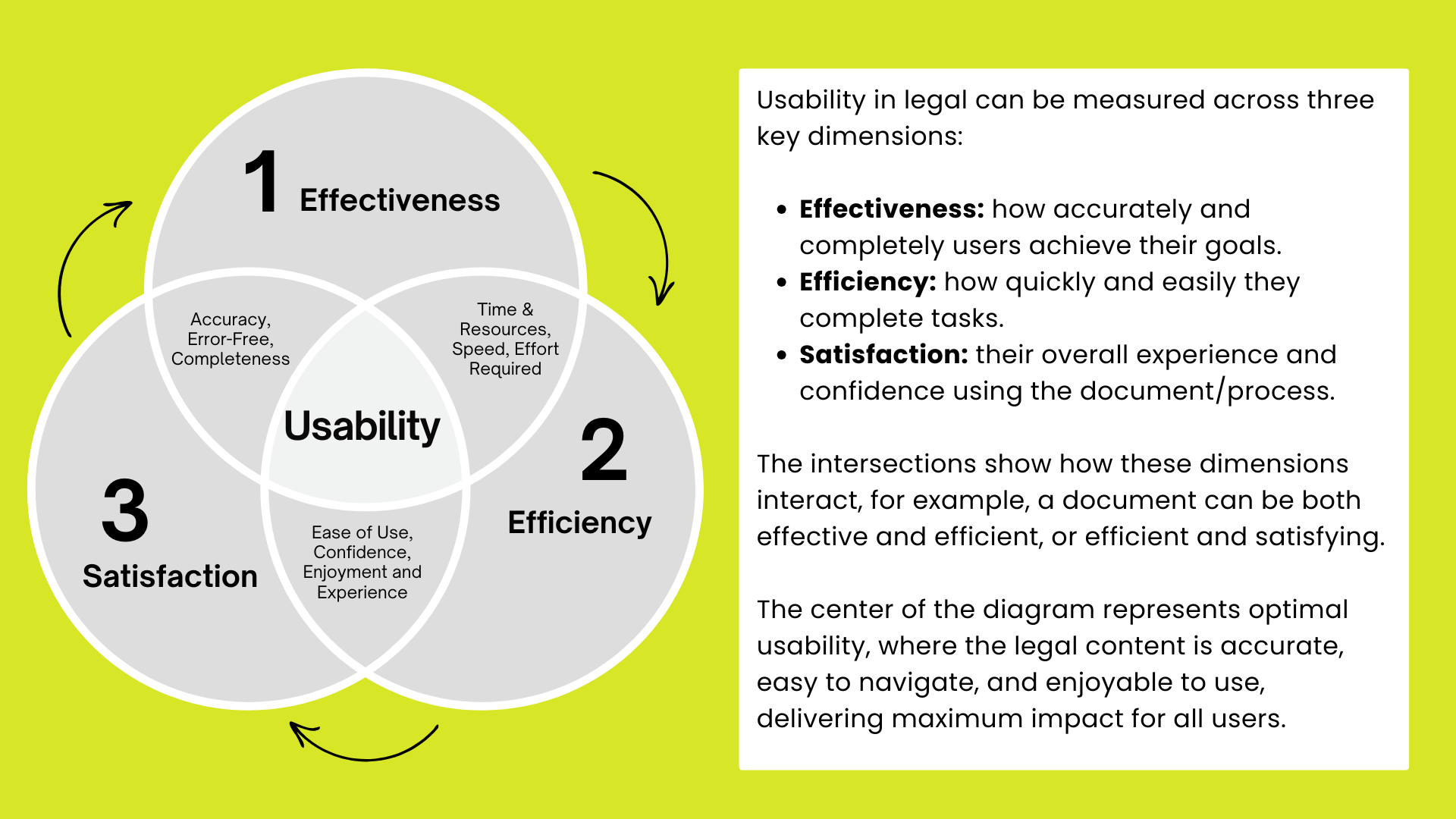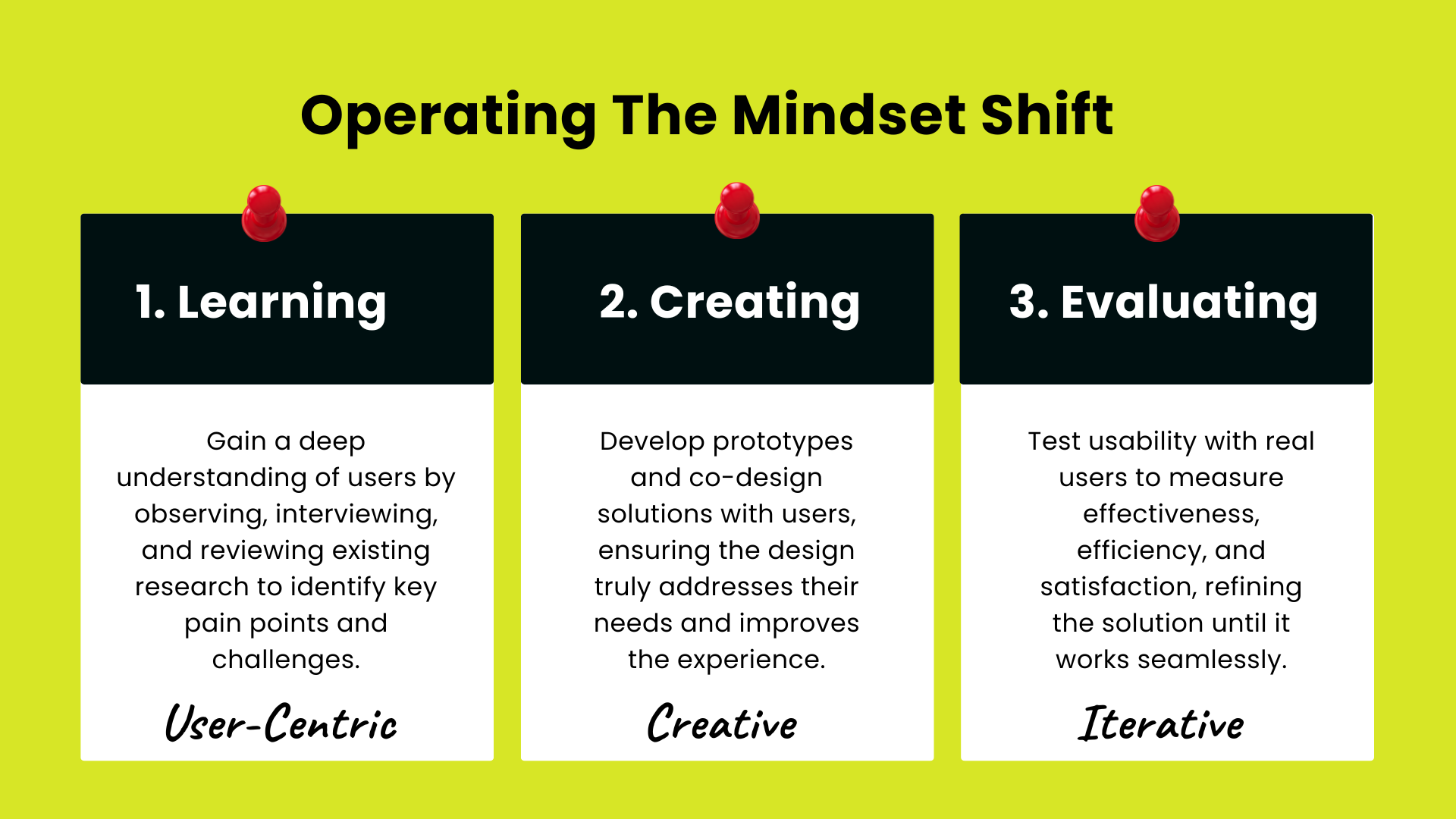What Is Legal Design? Origins, Process, and Why Usability Is the Core
Oct 01, 2025
Legal design is no longer a buzzword. It’s becoming a recognized discipline, with its own history, methodology, and growing body of research. But for many lawyers, business professionals, and even academics, the question remains: What exactly is legal design?
In this article, we’ll break it down, helping you see how effectiveness, efficiency, and satisfaction intersect to create truly user-centric legal documents and processes.
1. The Origins of Legal Design
The concept of “legal design” isn’t new. It was first coined in the 1990s by Professor Colette Brunschwig in Switzerland, during her PhD research. She went on to create the Center for Legal Visualization at the University of Zurich, pioneering research on how visuals could transform the way legal information is communicated.
The term gained broader visibility in 2013, when Margaret Hagan (Stanford University) gave one of the first working definitions:
Legal design is the application of human-centered design to the world of law, to make legal systems and services more human-centered, usable, and satisfying.
A few years later, the Legal Design Alliance, a collective of researchers and practitioners, refined this into a widely used definition:
An interdisciplinary approach to applying human-centered design to prevent or solve legal problems.
A standout article, Legal Design as a Discipline by Michael Doherty (2022), argued convincingly that legal design has grown into a discipline in its own right.
Fast forward to today, and the field is maturing. The WorldCC Contract Design Library, curated by Helena Haapio and Stefania Passera, was released. And the launch of the Legal Design Journal in 2024 signaled a new phase: research, case studies, and practical applications are now being compiled systematically.
2. The Common Thread: Usability
Across every definition, initiative, or case study, one word stands out: usability.
Usability is not just a guiding principle, it’s also measurable, which makes it the only objective metric to prove the real impact of Legal Design in action. By evaluating how easily users can navigate, understand, and complete tasks with a legal document or process, we can quantify improvements and demonstrate tangible results.
This is what sets Legal Design apart from purely aesthetic or theoretical approaches: you can show evidence of effectiveness. And because usability is both objective and easy to measure, we have always advocated for making it the cornerstone of both the definition and practice of Legal Design.
Usability is an international usability standards (ISO 9241), which focus on ease of use, efficiency, and satisfaction:
- Effective: Users make fewer errors. For example, a contract designed with clear language and visuals can be understood correctly on the first read.
- Efficient: Legal documents or services take less time and effort to use, reducing friction for everyone involved.
- Satisfying: Legal interactions feel less daunting and more approachable, which builds trust and encourages compliance.
With these goals in mind, legal design ensures that contracts, policies, and processes are not just legally sound, but truly relevant and useful.

Later in this article, we’ll discuss more how to successfully apply the methodology, measure usability, and track key metrics, but first, let’s look at some real-world examples that illustrate its power in practice.
3. Legal Design in Action
Legal design goes far beyond “making contracts pretty.” It’s being applied in diverse contexts worldwide:
-
Stanford Legal Design Lab: Known for justice innovation, from helping tenants fight eviction to rethinking traffic fines, now expanding into AI and access-to-justice research.
-
U.S. Department of Justice: The Access DOJ Initiative applies human-centered design to improve access to justice services. Two early case studies include:
-
Increasing access to bankruptcy meetings (with the U.S. Trustee Program).
-
Redesigning the presidential pardon application form to reduce complexity and barriers.
-
-
Our own community: Graduates of our certification program have pioneered:
-
Award-winning contracts for starts-ups and scale-ups in tech: Tunisian Legal Designer Dorra Harrar won the WorldCC Innovation & Excellence Award for making contracts clear, user-friendly, and actionable—lessons you can apply to your own work.
-
The first interactive beer contract: Teresa Parada Cano Lasso at Heineken Spain created the market’s first interactive beer contract, turning legal innovation into real value for people and business.
-
Developed new legal practices aligned with human-centric values: Blanca Leon left traditional law behind to create contracts of connection, where every agreement fosters clarity, trust, and real human connection.
-
4. A Universal Framework and Repeatable Process
At its heart, legal design applies human-centered design methods to legal. There are many ways practitioners implement Legal Design in practice, but at its core, it comes down to three essential elements:
-
Learning → Understand the needs of users, review existing research, and identify pain points.
-
Creating → Prototype and co-design solutions that better serve those needs.
-
Evaluating → Test usability to ensure solutions are easy, effective, and efficient.
Whether you’re a lawyer, in-house counsel, policymaker, or contract manager, embracing contract and legal design means moving away from complexity for complexity’s sake, and toward clarity, usability, and impact.

At the end of the day, the methodology will help:
-
Make legal documents and services easier to understand and use.
-
Reduce conflict, errors, and inefficiencies.
-
Build trust between organizations and the people they serve.
-
Drive measurable impact through usability testing and continuous improvement.
5. Why Usability is the Only Measurable Legal Design Metric
However you practice legal design, whether solo or in an interdisciplinary team, whether you use visuals or stick to text, whether you simplify language or not, the core goal remains the same: make the law more usable for the people who rely on it.
Usability is the only objective metric that reliably measures the impact of your work. Unlike subjective measures such as aesthetics, usability focuses on how effectively, efficiently, and easily users can interact with a document or process.
We track it through three key KPIs:
-
Effectiveness – Can users complete the task correctly?
-
Efficiency – How quickly and easily can they complete it?
-
Satisfaction – How confident or comfortable do they feel using it?
Here are 3 reasons why we love it and teach it in our Contract & Legal Design Practitioner program:
-
Flexible: The framework adapts to any contract or legal document scenario.
-
Practical: You only need 5 users to identify most of the usability issues, making it extremely cost-effective.
-
Proven impact: Usability gives you clear, objective evidence that your redesign improves the user experience.
When applying these KPIs to specific legal documents, you can break them down into measurable sub-metrics, depending on what you are working on a contract, under effectiveness, you could track accuracy of understanding, whether parties correctly interpret their rights and obligations on the first read. If you are working on a privacy policy, under satisfaction, you might track trust, how confident users feel that their personal data is handled transparently and securely.
If you are working on legal services, under efficiency, you might track burdens for both users and staff, like the U.S. Department of Justice is currently doing with its revised presidential pardon form - a perfect demonstration of how usability provides measurable, actionable results in legal design.
Legal design isn’t a trend. It’s a discipline, a measurable approach, and a toolkit for creating law that works in the real world.
In Conclusion ...
In conclusion, a more user-friendly way to define Legal Design is “enhancing the user experience of the law.” It’s simple, yet incredibly effective, and it captures everything we’ve always advocated for.
Whether you’re producing a contract, a policy, or redesigning workflows, the ultimate goal is the same: to improve usability for everyone involved. When legal documents and processes are designed with the user in mind, they become clearer, more accessible, and genuinely impactful. And the Certification Program is aligned to help you achieve just that.

